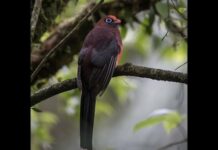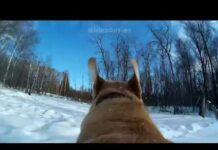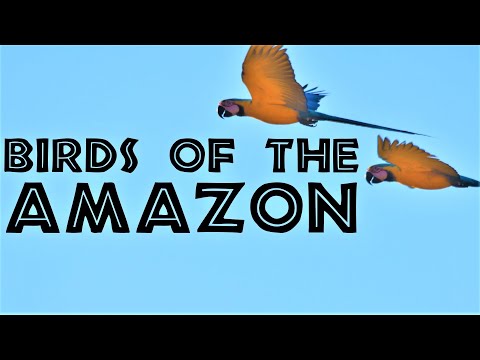Explore the Birds of the Amazon Rainforest, particullarly how to identify bird orders and families. The Continent of South America is home to about a third of the world’s living birds, a third of those are in the Amazon Basin, and about half of the birds in the Amazon basin can be found in south-east Peru where I am now, which is a total of over 500 species. These birds represent many of the world’s bird orders, meaning that by showing you a bunch of birds from this area I can create an educational video that will expose you to a lot of different bird taxa and their jizz, which means this video can both serve as an introduction to avian taxonomy and to birding, which you know is efficient. Birding can be made much easier if you know what taxonomic group a bird might be in, and this is where the jizz comes in. Jizz or giss is basically the overall impression a bird gives by its plumage, shape, movements, behavior, habitat choice, and any other aspect of a bird one can observe. Let’s Go Birding!
Corrections (Because Taxonomy is a mess)
parrots and falcons are not sister orders, parrots and passerines are sister orders with falcons being the sister to that super-order.
the taxonomy of Strisores (hummingbirds, swifts, potoo, nightjars) is a mess, molecular evidence suggests hummingbirds and swifts are nested among the other groups so cannot exist in their own order, unless all the birds are in their own orders.
Tyrannidae is also larger than Thraupidae.
00:00 Introduction
01:11 What is Jizz/Giss?
02:43 Tinamiformes (Tinamou)
03:24 Psittaciformes (Parrots, Macaws)
04:20 Piciformes (Woodpeckers, Toucans, Jacamar)
05:02 Trogoniformes (Trogons)
5:39 Trochilidae (Hummingbirds)
06:03 Cathartiformes (Vultures)
06:29 Accipitriformes (Birds of Prey)
07:01 Falconiformes (Falcons and Caracara)
07:19 Cracidae (Chachalaca and Guans)
07:43 Anseriformes (Horned Screamer)
08:03 Opisthocomiformes (Hoatzin)
08:56 Suliformes (Anghina)
09:08 Coraciiformes (Kingfishers and Motmots)
09:24 Pelecaniformes and Ciconiiformes (Herons and Storks)
09:50 Charadriiformes (Lapwings and Skimmers)
10:24 Gruiformes (Pale-winged Trumpeter)
10:55 Caprimulgiformes (Nightjar and Potoo)
11:54 Passeriformes (Perching Birds)
12:40 Thraupidae (Tanagers)
13:19 Mixed Flocks
14:01 Tyrannidae (Flycatchers)
14:32 Cotingidae (Screaming Piha and other Contigas)
15:33 Furnariidae (Woodcreepers)
16:11 Thamnophilidae (Antbirds)
17:26 Save the Amazon Rainforest
18:59 End Card
I try to achieve the most well researched content I can, that said it is impossible to create content that is exhaustive on a given topic and therefore I implore you to investigate a given topic further.
Welcome to Ecotasia! On this channel you can find wildlife footage and short documentaries on the natural world. I am an early career biologist who was inspired by the likes of the BBC Natural History unit, PBS, and Animal Planet as a child and then more recently by various nature YouTube channels to share my love for animals and nature. My goal is to document and highlight the interesting ecology and behavior of organisms I encounter, as well as cover and elucidate conservation and biological topics. Please Subscribe so you can join me to marvel and to learn twice a month.
Thanks to Ana Sapp for filming me on a boat in the jungle
Underwater Worlds
https://www.youtube.com/playlist?list=PLYx5OP7sbAZAJNusnxcNoHUx_sNDYT92k
Journey through the Undergrowth (Macro footage of insects and Arachnids)
https://www.youtube.com/playlist?list=PLYx5OP7sbAZC-4h2hpK09I-FF563TQzlc
Bird Playlist
https://www.youtube.com/watch?v=2ZqNM9k7OoY&list=PLYx5OP7sbAZACa11LD1wDQhn0SI2-SV1f
Birding Playlist
https://www.youtube.com/playlist?list=PLYx5OP7sbAZAYjq78IuGJI4wc0GXDRHTd
Conservation Playlist
https://www.youtube.com/playlist?list=PLYx5OP7sbAZAIUm5UCl84q2KU2nI3YLpx
#learning #birding #Amazon #Taxonomy
This is a video about Jizz… bird jizz specifically and how it helps you tell what kind of bird one you see out on the street or in the depths of a remote south american jungle is. And if you for some reason are not into birds, hello and welcome anyway, learning to recognize jizz is an important skill for any nature enthusiast. Now if you are confused what I am talking about or what jizz is hold on we will get to that in just a few minutes, because if I am going to have a chance to teach you the skill of recognizing it, I must choose somewhere intense, somewhere with a lot of birds, that's it, a remote south american jungle… The Continent of South America is home to about a third of the world’s living birds, a third of those are in the Amazon Basin, and about half of the birds in the Amazon basin can be found in south-east Peru where I am now,.
Which is a total of over 500 species. These birds represent many of the world’s bird orders, meaning that by showing you a bunch of birds from this area I can create an educational video that will expose you to a lot of different bird taxa and their jizz, which means this video can both serve as an introduction to avian taxonomy and to birding, which you know is efficient. Before we get too deep into the Rainforest, let's quickly talk about jizz and how you actually ID a bird, because for the uninitiated, bird field guides are a confusing mess, just plate after plate of bird illustrations, organized more or less by taxonomy, which because every guide has its own order, might make you want to scream. Using a guide no matter the order of birds however can be made much easier if you know what taxonomic group a bird might be in, and this is where the.
Jizz comes in. Jizz or giss is basically the overall impression a bird gives by its plumage, shape, movements, behavior, habitat choice, and any other aspect of a bird one can observe. It is a bit hard to explain because it is basically you see a bird and you identify it based on its vibe, which makes it sound like a bunch of nonsense, but it really helps you figure out what order, family, or even genus you are looking at, which means A. it narrows down your search and B means I can make a video about both jizz and taxonomy. The beauty is once you can recognize jizz, you can quickly flip through a bird guide and have a much smaller number of birds to look through, making it easier to recognize a bird that has the same field marks, and figure out exactly what you saw. Learning to recognize jizz does take some practice, which means you're in luck because it is now time to.
Head into the amazon, so when you see a bird on screen you can try to get a general impression of that bird, and hey maybe this video will teach you to become a master of recognizing jizz, probably not, but come with me now to the mighty Amazon rainforest on this bird finding quest. Ssh- ok we have a bird, it is a chicken-like thing without a very obvious tail running away from us through the understory. This secretive bird belongs to the order that is usually first in any neotropical field guide, a tinamou. Tinamou may look like chickens or quail, but are there own thing, there own bird order Tinamiformes, which is part of a far larger clade called the paleognaths, which is because there palate is more similar to reptiles than in other birds, Thus tinamou are more related to birds like ostrich and cassowary than chickens..
With some of the forest’s most hard to see bird inhabitants covered, let's talk about some of the most conspicuous birds, parrots. I mean mostly I am talking about macaws, because you could just be sitting around not even looking and be like “macaws”. I mean it is hard to miss a bright yellow or red bird that lets everyone in a 2 mile radius know exactly where it is. Macaws are parrots, and parrots make up the order psittaciformes. Basically all have a bill that is very curved, rather broad, and quite strong, which the macaws and many other parrots here use to crush the husks of fruit and seeds. Many parrots are not quite as conspicuous as macaws, just perching quietly letting their bright green plumage blend in with the dense foliage of the amazon canopy..
Parrots have special feet that are zygodactylous, two toes forward two toes backwards, which helps them clamber around on canopy branchesi, and is just like the next group of tropical birds we will be talking about that also often are quite conspicuous, the piciformes. Globally the most widespread piciformes are woodpeckers which use their zygodactyl feet to cling on to the trunks of trees, and usually are detected by their constant pecking of wood, more commonly called drumming, especially the loud double knocks of these red-necked woodpeckers in the genus campephilus. Here in the Amazon however, you can also get beautiful looks at toucans like this when they are up eating in the crowns of trees, though more often you hear there croaking bark of a call. Besides these more well known members of this bird order there are some lesser.
Known piciformes families, such this puffbird, or this jacamar which often perch watching for large flying insects, particularly butterflies that they will snatch out of the air, or this gilded barbet. This bird may be super colorful like many of the piciformes, but because this trogon is very still and quiet, they can be very hard to spot except when they fly from perch to perch. In the order trogoniformes this bird has what appear to be zygodactyl feet, but because which toes are facing forward or backwards are different, they are said to have heterodactyl feet because taxonomists are very specific about what body parts are what. Often when perching they slowly move their heads in a scanning behavior looking for food. Some guy probably saw a video of them and their quirks and came up with a ridiculous conspiracy.
Theory that they are some sort of government surveillance drone to mess with people on the internet and see how gullible humanity is. Hummingbirds are very endearing little birds with all sorts of fantasy names like fairies, sapphires, and coquettes in the order apodiformes in the family trochilidae. They are unlike any other bird, hovering around flowers, looking a lot like some of the moths pollinating the same flowers. The distinctive high chirps and buzzing wingbeats makes the group easy to notice, but they are so fast it can be really hard to identify them to species. What is that white dot in the distance? Wait a king vulture, that is actually a really exciting bird, perhaps the most beautiful bird in the order cathartiformes, since we are in South America and going to follow SACC, that would be.
The South American Classification committee, for the American ornithological society and call the new world vultures there own order. The entire group which also includes the local black and turkey vultures are scavengers searching for dead animals, the other species searching for turkey vultures as they have a good sense of smell that lets them detect a carcass under the thick canopy. Hawks and kites like this are in A…ac…accip…Accipitriformes, the birds of prey, basically you see them soaring about or perched on branches. They range in size from small hawks to eagles and somewhere around here there could be a harpy eagle, the most awesomest eagle of them all. Supposedly they perch on a branch waiting to see a monkey and come and grab it, and so are not just soaring about. Come on and grab the saki monkey, or one of these capuchins,.
Come on harpy eagle, grab a monkey and show yourself, I want to take in your magnificence. What was that horrible screaming sound? oh a black caracara, caracara and falcons like this laughing falcon look a lot like hawks, but are in their own order falconiformes, sister to the parrots, which makes sense because it is their noises that I almost always notice first. Now this is another very loud bird, a speckled chachalaca, which like most of the gamebirds, or galliformes species in the amazon are in the family Cracidae, which includes chachalaca, guan, and curassow. Often you see these birds up in trees making a lot of noise. Their large size and loud nature has meant these birds are often over hunted and so much rarer in places around settlements. That is a really big bird, a horned screamer,.
It doesn't really look like any other bird, kind of has something that looks like an alien antennae coming off its head, but is actually in the bird order anseriformes, which includes duck and geese, they are just are there own thing that diverged a very long time ago just after the extinction of the non-avian dinosaurs. Speaking of dinosaurs and really weird birds, this is a hoatzin. If you cannot immediately identify a bird with a punk-rock crest and orange coloration living in branches hanging over the side of an oxbow lake, and sounds like a pissed off velociraptor, then I don’t know you might not be cut out for birding, don’t worry though you can still be a bird watcher, those terms are different things, never call a serious birder a birdwatcher, you might find you self chained to a rock with an.
Eagle eating your liver, wait I think that is a punishment for something else, what were we talking about again, right hoatzin. They eat leaves which is a pretty unusual diet for a bird, who am i kidding, everything about these birds is kind of unusual, the babies even have wing claws they use to climb up trees with. This combination of features puts hoatzin in their own order, which I know I cannot pronounce, one of only a few bird orders containing a single species. Paddling around in one of these oxbow lakes you see a lot of other birds besides the hoatzin, like this anghina, they are a darter, part of a small family of diving birds similar but not the same as cormorants in the order suliformes. Also on the oxbow lake are kingfishers, which dive into the water from perches to grab the small fish of the lake..
They are members of core…coral…coraciiformes, which also includes the motmot, pretty tropical birds you might spot around in the rainforest. Back to fish eating birds, you can see quite a few heron species along the shores of the rivers and lakes here. Like the capped heron, or this cocoi heron. These are birds in the order pelecaniformes with long legs and sharp beaks. Storks kind of look like herons with their long beaks and legs, but are completely different and in the order ciconiiformes. These bird’s large size and distinctive field marks make them unmistakable, bald head, long strong beak, you really would not want them anywhere near a baby. On the banks of the river with all these herons and storks there are often smaller birds belonging to the order charadriiformes, which includes gulls, terns and shorebirds like.
This pied lapwing. Wow, I can't get too close, because I don't want to sink into that quicksand. That would be kind of annoying and embarrassing as one of the premier quicksand experts on YouTube. Safely away from the quicksand you might find these odd birds flying over the river, black skimmers. They have a long lower bill they put into the river to skim for prey, snapping the beak shut when it strikes a fish or, if the bird is really unluckily, a caiman. Back in the forest, you can find these funny looking birds, pale-winged trumpeters. They are in the same order as cranes and rails, gruiformes. They are very skittish and so you have to be quiet and a little lucky to get very close as they forage on fallen fruit. The flocks can be quite large and with their very light colored wings it can be rather surreal to see.
Them around sunset from a distance, with all these moving dots running away, and for a few seconds you have no clue what you are looking at. Wait up for me, it is getting hard to see anything. With night upon the rainforest, nocturnal birds begin to stir. Yeah you can hear some owls, but I want to just not talk about strigiformes, because they are too hard to see. But if you shine a light in the amazonian night you might see glowing red eyes, a common pauraque. This is a nightjar in the order caprimulgiformes. If you are really lucky you may even see something like this, a long-tailed potoo, which is in the order..; yeah no way i am going to try pronouncing that. when did this order split happen? taxonomy can be such a nightmare, always changing and all that, can never keep up, does this mean my 5 hr collaboration with Steve Bush is now outdated,.
Is this video going to be outdated soon, is all my content going to be outdated soon… ok JJ, get out of this existential spiral, look at the potoo, look at it blinking its little nictitating membrane, just keep trying to look like a stump potoo. I kind of want a staff with a carved potoo on it now. Well it's a new day and there is only one bird order to talk about, this is going to be nice and simple, and of course it is passeriformes, yes the juggernaut of bird taxonomy, half of every bird species is a perching bird, and while they are all the same order they basically do everything all the other birds do, swallows fly through the air and eat small insects like the swifts, close kin of hummingbirds. Then they do lots of things other birds don’t do, like weave complex penduline nests.
And make a bunch of weird noises like these caciques. They are usually split into the oscines, aka the song birds, and the suboscines, which don’t have a cute common name because most of them are secretive brown birds in the rainforest. I am going to Talk about an oscine passerine family before we get into the obscure stuff. Now this is a bird group with some serious jizz, the tanagers and I am not talking about those tanagers we get in the US, those are cardinals, these are the real tanangers in the family thraupidae, the largest family of passerines. Silver-beaked tanagers are one of the more common species, are pretty vocal, move a lot, and have that very bright beak on a nearly black bird that sometimes you can see the red on when the light is right. I think this sort of.
Illustrates tanager jizz is something like a colorful perching bird that is pretty active, which can make the swallow tanager like this one sometimes hard to immediately place because it is a pretty chill bird, but definitely has something tanager-ish about it. Anyway in our search for some suboscine passerines, we may run into one of the most spectacular birding opportunities in the rainforest, mixed flocks. Here groups of different birds move through the forest hunting insects, all specialized to use different techniques for catching them, and so the flock can feed as a group. Usually you get like a woodcreeper, some antwrens, a vireo or flycatcher, maybe even a cuckoo. Some of these mixed flocks are super spectacular with birds moving like a column through the forest all the way from the forest.
Floor to the top of the canopy. The challenge with mixed flocks are all the LBJ’s, no not that LBJ, little brown jobs, or little brown birds are very hard to identify with any certainty, especially if they are high in the trees. So in terms of suboscine birds the tyrant flycatchers are pretty well known, mainly due to several migratory species in North America, but in the amazon there is like kind of a ridiculous number of tyrannidae species, pretty distinctive jizz, perching in one spot, acting all alert, then fly off and grab an insect then return to the same spot in a behavior known as hawking. They come in all sorts of colors, many have yellow breasts, the vermillion flycatcher is super striking, and oh I can't believe it, this is a really good one, super exciting… the drab water tyrant. So I kind of have ignored sound and.
Birding by ear, because it is like the next step I am yet to really get good at, but in the amazon there is one noise you better know because it is so ubiquitous… the screaming piha, that is actually not a bad name for a heavy metal band. Anyway with such a spectacular exotic sound, this bird must be amazing. Oh, it's gray. It is a member of the passerine family Cotingidae, a uniquely neotropical bird family, which has to be the most eclectic collection of birds you could find. You get some boring bird like a screaming piha, still great name, but then it's like here is an iridescent blue plum-throated cotinga, or in the mountains of costa rica you got the really funky looking three-wattled bell bird, or something like a cock-of-the-rock in other parts of south america..
That bird definitely has a distinctive jizz. What is up with this bird family? How can this plain gray bird possibly be part of the same family as this party bird, someone please explain contigas to me, I do not get them. Another uniquely neotropical passerine family that is pretty abundant in the Amazon are furnariids. They get this name because someone through the clay nests of this bird, a Horneo, looks like an oven, and thus are called ovenbirds, despite most birds not making this kind of nests. Usually in the rainforest you see birds like this, a woodcreeper, which move up and down tree trunks before flying to the next tree. There are also a lot of other birds in this family with really epic names you will definitely recognize as birds: like Xenops, tree haunters, foliage gleaners,.
Leaf tossers, and spinetails, I never see cool stuff like that though. Wait, is this a column of Army ants? You know what that means, it's time to bird an ant swarm… At ant swarms you can usually find antbirds looking to snatch any bugs fleeing the army ant swarm, like this white-throated antbird an obligate ant follower, only found at ant swarms, or this sooty antbird which may also be seen foraging in the forest away from the ants. Actually Most of the over 230 species, which is a lot for bird species, in the family thamnophilidae are not even ever seen at ant swarms and can be glimpsed bouncing around in the thick vegetation of the rainforest and includes more than just antbirds; there are also the antwrens, antshrikes, and the bushbirds, which I hear are only worth half of a bird in hand..
While you probably have never heard about them, antbirds are some of the most common birds you see in the Amazon, and so understanding the family's jizz and individual species field marks is critical for birding here. I find they move every few seconds from one perch to the next. Oh here we go, I finally found my good bird pictures from the Amazon. I was wondering where they went, well I guess we are to the conservation message for the video, so can we get like some music that tugs at peoples heartstrings, yeah that will work. I am going to be real with you, the Amazon Rainforest is under unprecedented threat, and thus all the birds that inhabit it are also in danger, along with all the mammals, reptiles, insects, and the rest of biodiversity I am not going to mention.
Because we will be here all day if I do, but the point is you have the ability to help. The Amazon Conservation Association or Amazon Aid Foundation are two groups working to protect the rainforest, the Amazon Conservation Association operates their own protected forests, and the Amazon Aid foundation is working to take a holistic approach to combating deforestation, especially that from widespread gold mining, which I spent several weeks watch happen. Beyond giving money, there are also actions you can personally take to protect the Amazon, back to gold, if you are purchasing gold jewelry make sure it is coming from a responsible source and not some illegal rainforest mining camp. Then to combat one of the other major reasons for deforestation in the Amazon Basin, which is cattle ranching and soy production to feed livestock, reduce or completely.
Cut your consumption of meat, or at the very least make sure you actually know the source of the meat you are eating. Taking these steps can ensure a future for these forests and all the birds, bugs, beasts, bacteria, basidiomycota, botanical wonders, and the rest of the biodiversity within. So that was a video I guess, seriously though thank you for watching this nonsensical journey through the birds of the Amazon rainforest hung on some loose idea of combining birding and avian taxonomy into a video, all the way to the end card. If you enjoyed this video, may I recommend my video on birding the pacific slope of costa rica, or one of my birding vlogs.
We are excited to present to you the captivating video titled “Birds of the Amazon Rainforest and How to Find Them”. Get ready to embark on a journey of enjoyment, smiles, and laughter as you watch this delightful creation. “Birds of the Amazon Rainforest and How to Find Them” is a perfect blend of entertainment and amusement, carefully crafted to bring joy to your day. From the moment you press play, you’ll be greeted with a cascade of lighthearted moments, heartwarming scenes, and perhaps even a few surprises that will tickle your funny bone.
Whether you’re in need of a quick pick-me-up or simply looking for some light-hearted entertainment, “Birds of the Amazon Rainforest and How to Find Them” has you covered. The video promises to deliver a collection of moments that are bound to leave you grinning from ear to ear. With its engaging content and skillful presentation, “Birds of the Amazon Rainforest and How to Find Them” is more than just a video – it’s an experience designed to brighten your mood and spread positivity.
The creators of “Birds of the Amazon Rainforest and How to Find Them” have poured their creativity and dedication into crafting a visual treat that resonates with audiences of all ages. Through expert storytelling, impeccable timing, and an array of engaging content, “Birds of the Amazon Rainforest and How to Find Them” promises to be an unforgettable journey that lingers in your memory long after the video concludes.
So sit back, relax, and prepare to be entertained as you dive into the world of “Birds of the Amazon Rainforest and How to Find Them”. It’s a delightful video that aims to bring a dose of happiness to your day, leaving you with a lasting smile and a heart full of laughter.
This video was uploaded in youtube and has recieved 467 views so far. This is a great achievement and laso it has received 12 likes and .
Data bout the video:
Rating: ,
Video dimensions: 2d,
Video definition: hd,
Video duration: 00:19:26,
Video favourite count: 0
Video comment count: 16




















